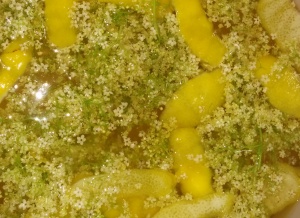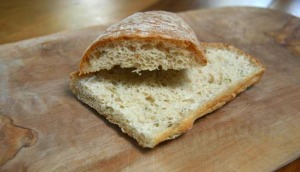It’s time for an update on the brew. After about a week in the demijohn the bubbling stopped, indicating it was time to measure the specific gravity. This showed a reading of 994 which was a good bit lower than the target of 1010. To remedy this we made a sugar syrup of 240 g of sugar in about 200 ml of water and added this to the demijohn (once the syrup had cooled down). We followed the guideline of adding 100 g of sugar per 5 litres to raise the SG by 7.5 points. When we remeasured the SG it showed a reading of 1015 which was probably fine given that the solution will ferment a bit more in the bottles. So we then siphoned the solution into sterilised plastic bottles, screwed the lids on and left them to ferment further to add some fizz. You could see that the yeast was settling out to leave a slightly hazy solution.
Whilst we were doing this we also started another brew up as there were still plenty of flowers on the bushes. We followed the same procedure as before except that we used a different champagne yeast which required rehydrating beforehand. We also measured the original specific gravity. This was 1075 which should give us a final alcohol content of 9.7%. When we came to transfer the must to the demijohn we siphoned it instead of filtering through a muslin bag which was quite a bit easier, however we did notice a few of the elderflower petals made it through into the demijohn. I’ll update next when we crack open the first bottle for a taste.




